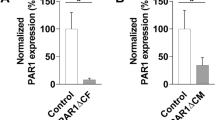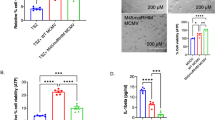Abstract
We examined heart tissues of AIDS patients with or without HIV cardiomyopathy (HIVCM) by immunohistocheistry, in situ polymerase chain reaction, in situ riboprobe hybridization, and the TUNEL technique for apoptosis. In HIVCM tissues, only inflammatory cells, but not endothelial cells or cardiomyocytes, displayed HIV-1 DNA and RNA. However, macrophages, lymphocytes, and—in a patchy fashion—cardiomyocytes and endothelial cells exhibited virus envelope protein gp 120. Macrophages infiltrated the myocardium in a perivascular fashion and expressed tumor necrosis factor family ligands; adjacent cardiomyocytes suffered apopotosis. in vitro HIV-1 strongly invaded neonatal rat ventricular myocytes (NRVMs) and coronary artery endothelial cells (CAECs) and induced microvilli but did not replicate. HIV-1, gp120, or Tat induced Erk 1/2 phosphorylation, activation of caspase-3, and apoptosis of NRVMs and CAECs; all of these were inhibited by a MAPK/ERK-kinase (MEK) inhibitor U0126. The pathogenesis of HIVCM involves HIV-1 replication in inflammatory cells and induction of cardiomyocyte apoptosis by (1) the extrinsic pathway through apoptotic ligands and (2) the intrinsic pathway through direct virus entry and gp120-and Tat-proapoptotic signaling.
Similar content being viewed by others
References
Liu, N.Q., Lossinsky, A.S., Popik, W., Li, X., Gujuluva, C., Kriederman, B., et al. (2002). Human immunodeficiency virus type 1 enters brain microvascular endothelia by macropinocytosis dependent on lipid rafts and the mitogen-activated protein kinase signaling pathway. J. Virol. 76: 6689–6700.
Liu, Q.N., Reddy, S., Sayre, J.W., Pop, V., Graves, M.C., and Fiala, M. (2001). Essential role of HIV type 1-infected and cyclooxygenase 2-activated macrophages and T cells in HIV type 1 myocarditis. AIDS Res. Hum Retroviruses 17:1423–1433.
Twu, C., Liu, N.Q., Popik, W., Bukrinsky, M., Sayre, J., Roberts, J., et al. (2002). Cardiomyocytes undergo apoptosis in human immunodeficiency virus cardiomyopathy through mitochondrion- and death receptor-controlled pathways. Proc. Natl. Acad. Sci. USA 99:14386–14391.
Grody, W.L.C. and Lewis, W. (1990). Infection of the human heart by the human immunodeficiency virus. Am. J. Cardiol. 66:203–206.
Lipshultz, S.E., Fox, C.H., Perez-Atayde, A.R., Sanders, S.P., Colan, S.D., McIntosh, K., et al. (1990). Identification of human immunodeficiency virus-1 RNA and DNA in the heart of a child with cardiovascular abnormalities and congenital acquired immune deficiency syndrome. Am. J. Cardiol. 66:246–250.
Rodriguez, E.R., Nasim, S., Hsia, J., Sandin, R.L., Ferreira, A., Hilliard, B.A., et al. (1991). Cardiac myocytes and dendritic cells harbor human immunodeficiency virus in infected patients with and without cardiac dysfunction: detection by multiplex, nested, polymerase chain reaction in individually microdissted cells from right ventricular endomyocardial biopsy tissue. Am. J. Cardiol. 68:1511–1520.
Kandolf R., Ameis, D., Kirschner, P., Canu, A., and Hofschneider, P.H. (1987). In situ detection of enteroviral genomes in myocardial cells by nucleic acid hybridization: a approach to the diagnosis of viral heart disease. Proc. Natl. Acad. Sci. USA 84:6272–6276.
Cioc, A.M. and Nuovo, G.J. (2002). Histologic and in situ viral findings in the myocardium in cases of sudden, unexpected death. Mod. Pathol. 15:914–922.
Chen, F., Shannon, K., Ding, S., Silva, M.E., Wetzel, G.T., Klitzner, T.S., et al. (2002). HIV type 1 glycoprotein 120 inhibits cardiac myocyte contraction. AIDS Res. Hum. Retroviruses 18:777–784.
Kan, H., Xie, Z., and Finkel, M.S. (2000). HIV gp120 enhances NO production by cardiac myocytes through p38 MAP kinase-mediated NF-kappaB activation. Am. J. Physiol. Heart Circ. Physiol. 279:H3138-H3143.
Chaves, A.A., Mihm, M.J., Schanbacher, B., Basuray, A., Liu, C.Y., Ayers, L.W., et al. (2003). Cardiomyopathy in a murine model of AIDS: evidence of reactive nitrogen species and corroboration in human HIV/AIDS cardiac tissues. Cardiovasc. Res. 60:108–118.
Carr, A. and Cooper, D.A. (2000). Adverse effects of antiretroviral therapy. Lancet 356:1423–1430.
Frerichs, F.C., Dingemans, K.P., and Brinkman, K. (2002). Cardiomyopathy with mitochondrial damage associated with nucleoside reverse-transcriptase inhibitors. N. Engl. J. Med. 347:1895–1896.
Mossman, S.P., Bex, F., Berglund, P., Arthos J., O'Neil, S.P., Riley, D., et al. (1996). Protection against lethal simian immunodeficiency virus SIV smmPBj14 disease by a recombinant Semliki Forest virus gp160 vaccine and by a gp120 subunit vaccien. J. Virol. 70:1953–1960.
Deng, L., Ammosova, T., Pumfery, A., Kashanchi F., and Nekhai, S. (2002). HIV-1 tat interaction with RNA polymerase II C-terminal domain (CTD) and a dynamic association with CDK2 induce CTD phosphorylation and transcription from HIV-1 promoter. J. Biol. Chem. 277:33922–33929.
Gujuluva, C., Burns, A.R., Puskharsky T., Popik, W., Berger, O., Bukrinsky, M., et al. (2001). HIV-1 penetrates coronary artery endothelial cells by transcytosis. Mol. Med. 7:169–176.
Bruggeman, L.A., Dikman, S., Meng, C., Quaggin, S.E., Coffman, T.M., and Klotman, P.E. (1997). Nephropathy in human immunodeficiency virus-1 transgenic mice is due to renal transgene expression. J. Clin. Invest. 100:84–92.
Bruggeman, L.A., Ross, M.D., Tanji, N., Cara, A., Dikman, S., Gordon, R.E., et al. (2000). Renal epithelium is a previously unrecognized site of HIV-1 infection. J. Am. Soc. Nephrol. 11:2079–2087.
Strappe, P.M., Wang, T.H., McKenzie, C.A., Lowrie, S., Simmonds, P., and Bell, J.E. (1998). In situ polymerase chain reaction amplification of HIV-1 DNA in brain tissue. J. Virol. Methods 70:119–127.
Nuovo, G. (1997). PCR in Situ Hybridization: Protocols and Amplifications, 3rd ed. New York, NY: Lippincott-Raven.
Lossinsky A.S. and Shivers, R.R. (2003). Studies of cerebral endothelium by scanning and high-voltage electron microscopy. In: Nag, S. (eds.) The Blood-Brain Barrier: Biology and Research Protocols. Totowa, NJ: Humana Press, pp 67–82.
October 2002. Available at:http://www.pnas.org.Accessed February 27, 2004.
Barbaro, G. and Lipshultz, S.E. (2001). Pathogenesis of HIV-associated cardiomyopathy. Ann NY Acid. Sci. 946:57–81.
Fiala, M., Looney, D.J., Stins, M., Way, D.D., Zhang, L., Gan, X., et al. (1997). TNF-alpha opens a paracellular route for HIV-1 invasion across the blood-brain barrier. Mol. Med. 3:553–564.
Zhang, L., Looney, D., Taub, D., Chang, S.L., Way, D., Witte, et al. (1998). Cocaine opens the blood-brain barrier to HIV-1 invasion. J. Neuro. Virol. 4:619–626.
Reid, W., Sadowska, M., Denaro, F., Rao, S., Foulke J. Jr., Hayes, N., et al. (2001). An HIV-1 transgenic rat that develops HIV-related pathology and immunologic dysfunction. Proc. Natl. Acad. Sci. USA 98:9271–9276.
Bruggeman, L.A., Thomson, M.M., Nelson, P.J., Kopp, J.B., Rappaport, J., Klotman, P.E., et al. (1994) Patterns of HIV-1 mRNA expression in transgenic mice are tissue-dependent. Virology 202:940–948.
Kay, D.G., Yue, P., Hanna, Z., Jothy, S., Tremblay, E., and Jolicoeur, P. (2002). Cardiac disease in transgenic mice expressing human immunodeficiency virus-1 nef in cells of the immune system. Am. J. Pathol. 161:321–335.
Shannon, R.P., Simon, M.A., Mathier M.A., Geng, Y.J., Mankad, S., and Lackner, A.A. (2000). Dilated cardiomyopathy associated with simian AIDS in nonhuman primates. Circulation 101:185–193.
Barbaro, G., Barbarini, G., and Pellicelli, A.M. (2001). HIV-associated coronary arteritis in a patient with fatal myocardial infarction. N. Engl. J. Med. 344:1799–1800.
Author information
Authors and Affiliations
Corresponding author
Rights and permissions
About this article
Cite this article
Fiala, M., Polik, W., Qiao, JH. et al. HIV-1 induces cardiomyopathy by cardiomyocyte invasion and gp120, tat, and cytokine apoptotic signaling. Cardiovasc Toxicol 4, 97–107 (2004). https://doi.org/10.1385/CT:4:2:097
Received:
Revised:
Accepted:
Issue Date:
DOI: https://doi.org/10.1385/CT:4:2:097




